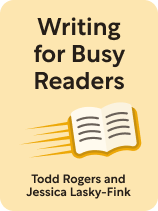

This article is an excerpt from the Shortform book guide to "Writing for Busy Readers" by Todd Rogers and Jessica Lasky-Fink. Shortform has the world's best summaries and analyses of books you should be reading.
Like this article? Sign up for a free trial here.
How is effective writing different than literary writing? Why is effective writing important when it comes to business?
In the book Writing for Busy Readers, behavioral scientists Todd Rogers and Jessica Lasky-Fink discuss the importance of effective writing. They say that effective writing is captivating and impactful, which are important if you’re trying to prompt action.
Here’s a look at the two main benefits of effective writing.
The Importance of Effective Writing
Every piece of writing has a purpose—for example, you might write marketing emails to alert customers to flash sales or political flyers to inform citizens about a politician’s campaign.
To achieve your writing’s purpose, Rogers and Lasky-Fink argue that you must write effectively. Let’s explore what that means and the importance of effective writing.
What Is Effective Writing?
According to Rogers and Lasky-Fink, the importance of effective writing can’t be overstated. Effective writing conveys essential information without unnecessary complexity. It’s purposeful—that is, it’s tailored to have a particular impact on readers. It’s also clear, concise, and direct to accommodate readers’ time limitations.
The authors note that almost every reader has limited time: The world is busier than ever, and we’re constantly inundated with information. To cut through the noise, effective writers make it easy for readers to quickly understand their message, its relevance and importance, and how to act on the information it contains. As we’ll discuss, this convinces readers that your content is worth engaging with, ensuring that your ideas have a greater impact by reaching more people.
Effective writing is distinct from literary writing—the kind of writing used in novels and other creative content—which is intentionally complex because readers enjoy taking time to parse its meaning and appreciate the beauty of its language. In contrast, Rogers and Lasky-Fink say to use effective writing when trying to convey information, solve problems, or prompt specific actions. For example, you can use effective writing techniques to announce an event, provide instructions, and convince others of your viewpoint.
Benefits of Writing Effectively
According to Rogers and Lasky-Fink, effective writing has two primary benefits: First, it captivates readers. Second, it’s more impactful than other kinds of writing. Let’s explore each benefit in more detail.
Benefit #1: Effective Writing Captivates Readers
The authors explain that readers want to read effective writing; they’re not likely to ignore it the way they do ineffective writing. People tune out ineffective writing because humans’ capacity for attention is inherently limited. Our brains constantly take in vast amounts of information—so much that we can’t make sense of it all. As a result, we make unconscious choices about what to focus on and what to ignore. For example, right now, you’re focused on reading this guide, so you might be tuning out your dog’s snores or your phone’s notifications. But focusing is difficult work; it requires significant brainpower to ignore distractions and resist the urge to multitask, and your focus can be depleted relatively quickly.
(Shortform note: In Peak Mind, neuroscientist Amishi Jha explains why our capacity for attention is so limited. According to Jha, the brain’s attention system is made of three parts. The orienting system narrows in on specific information and suppresses distractions, helping you focus on a single subject. Meanwhile, the alerting system maintains broad awareness of your environment, and the executive system juggles your goals and priorities to help you plan ahead. These three subsystems share a single pool of mental resources, so when one ramps up, another steps back. So, if your dog suddenly starts barking as you read this guide, your alerting system will kick in, and your orienting system will disengage, making it harder to focus on your reading.)
Since readers’ attention is limited, you must convince your audience that reading your content should rank high on their list of priorities. When a reader comes across a piece of writing, they make an instant, intuitive decision about how deeply to engage with it by weighing its benefits (for example, learning about an issue they care about) against its costs (time and energy). The authors note that this analysis forms the basis of most human decision-making: We naturally prefer experiences that require low effort but yield immediate rewards.
Rogers and Lasky-Fink say the more effective your writing is, the more likely you’ll capture your readers’ attention. When your content pops up on their screen, they’ll take a quick look at it and understand immediately that it’s easy to focus on, easy to process, and full of valuable information. Since the benefits of reading your content outweigh the costs, they’ll choose to read it.
| Nudging Your Readers By Writing Effectively Rogers and Lasky-Fink explain that quick cost-benefit analyses underlie most human decisions, including which content to read. In Nudge, Richard H. Thaler and Cass R. Sunstein expand on this, explaining that we use heuristics, or rules of thumb, to perform these cost-benefit analyses instantaneously. That way, we don’t spend forever deliberating over every choice. However, Thaler and Sunstein write, our heuristics are often flawed. For example, some of us rely too much on the representativeness bias—we judge things based on how similar they are to stereotypes. For instance, if you’re deciding whether to read an article and the headline sounds too technical or academic, you might assume it’s not for you because you associate that type of content with difficulty or boredom. However, the article might actually be accessible, engaging, and very much worth reading. Thaler and Sunstein argue that since our heuristics are flawed, we often make poor decisions. Therefore, choice designers—like policymakers—should structure options in ways that subtly “nudge” people to make better decisions. For example, policymakers might require the food industry to clearly label products with nutritional information, which makes it easier for consumers to make healthier choices without needing to spend extra time analyzing each product. As a writer, you’re a kind of choice designer. You present information (your content) to a decision-maker (your audience) with the hope that they’ll make a certain choice (reading your content and acting on its ideas). You believe your audience will benefit from reading it, so your goal is to make it easy for them to see its value right away. In other words, you want to make intentional writing choices that nudge the reader toward engagement by minimizing the effort it takes to read and maximizing the immediate rewards. This is the goal of effective writing. |
Benefit #2: Effective Writing is More Impactful
Rogers and Lasky-Fink also state that effective writing is more likely to have the impact you desire on your readers. Since effective writing captivates readers, they’re more likely to interact with, understand, and integrate your message into their worldview. As a result, Rogers and Lasky-Fink argue, effective writing has a positive impact on society.
The authors explain that ineffective writing confuses or even repels readers, particularly those who face barriers like limited literacy. This prevents many readers from understanding and making use of the world’s most important ideas. For example, if a government policy is poorly written, citizens may not understand their rights and responsibilities. Similarly, if a surgical patient is confused by the hospital’s aftercare instructions, they may neglect crucial aspects of their recovery. In contrast, when government policies, medical instructions, and other key communications are written effectively, people can make more informed decisions about their lives, which helps us build a healthier society.
| Knowledge Is Power—But So Is Misinformation Rogers and Lasky-Fink argue that since effective writing is more accessible, it has a positive impact on society. In Nexus, philosopher Yuval Noah Harari makes a similar point, arguing that the increasing availability of information is one of the most powerful forces shaping modern life. However, he warns that this power can cut both ways: Just as good information can empower people, misleading information can manipulate them. Rogers and Lasky-Fink assume that their audience won’t use their writing tips for nefarious purposes, so their intent is to show how to communicate beneficial ideas effectively. However, bad actors also use effective writing to peddle bad information. For example, research shows that misinformation is often easier to read, in terms of cognitive effort, than factual news stories. This may explain why “fake news” has gained so much purchase in the US, where more than half of adults read below the sixth-grade literacy level. Studies show that such misinformation has negative impacts on people’s mental and physical health. |

———End of Preview———
Like what you just read? Read the rest of the world's best book summary and analysis of Todd Rogers and Jessica Lasky-Fink's "Writing for Busy Readers" at Shortform.
Here's what you'll find in our full Writing for Busy Readers summary:
- Why some writers are so successful at connecting with readers while others aren't
- How to make your writing more impactful and increase your reach
- That how you communicate can be just as important as what you say






